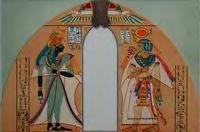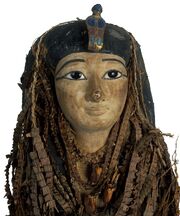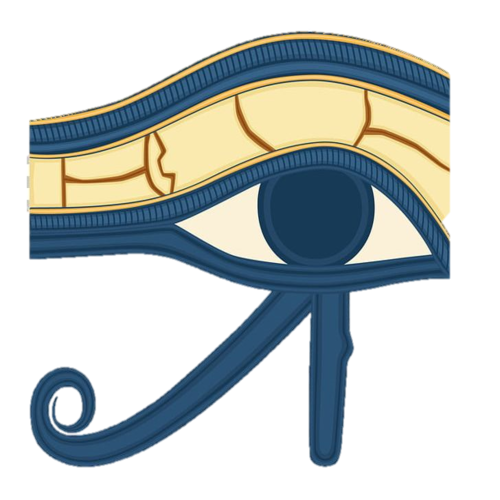| Preceded by: Ahmose II |
Pharaoh of Egypt 18th Dynasty |
Succeeded by: Thutmose I | ||||||||||||||
| Amenhotep I | ||||||||||||||||
|---|---|---|---|---|---|---|---|---|---|---|---|---|---|---|---|---|
| Hellenized: Amenophis I | ||||||||||||||||
| Reign | 1525-1504 BC or 1515-1494 BC (21 years) | |||||||||||||||
| Praenomen |
Holy is the Soul of Re | |||||||||||||||
| Nomen |
Amun is Pleased/Satisfied | |||||||||||||||
| Horus name |
Bull who Subdues the Lands | |||||||||||||||
| Nebty name |
He who inspires Great Fear | |||||||||||||||
| Golden Horus |
Enduring for Years | |||||||||||||||
| Father | Ahmose II | |||||||||||||||
| Mother | Ahmose-Nefertari | |||||||||||||||
| Consort(s) | Ahmose-Meritamen | |||||||||||||||
| Died | 1504 or 1494 BC | |||||||||||||||
| Burial | KV39, TT293 or ANB (initial?), TT320 (reburial) | |||||||||||||||
| Monuments | White Chapel Replica at Karnak Alabaster barque shrine at Karnak | |||||||||||||||
- For other pages by this name, see Amenhotep.
Djoserkare Amenhotep I (transliteration: ỉmn-ḥtp, meaning: "Amun is Pleased/Satisfied", Hellenized: Amenophis) was the second Pharaoh of the Eighteenth Dynasty of Egypt during the New Kingdom. He inherited the kingdom formed by the military conquests of his father, and maintained dominance over Nubia and the Nile Delta, however probably did not attempt to keep power in Syrio-Palestine. He continued to rebuild temples in Upper Egypt, and revolutionized mortuary complex design by separating his tomb from his mortuary temple, setting a trend which would persist throughout the entire New Kingdom. His reign is generally dated from 1526 to 1506 B.C.E. or 1525 to 1504 B.C.E.[1]
Name[]
Amenhotep I is known as Amenophis (Aμενωφις) in Manetho's Epitome. Upon coronation, Amenhotep I adopted the throne name (or prenomen) Djoserkare (transliteration: ḏsr-kꜣ-rꜥ, meaning: "Holy is the soul of Re"). He is occassionally attested with the epithet Heqawaset (transliteration: ḥqꜣ wꜣst, meaning: "Ruler of Thebes") after his birth name (or nomen). His name may thus be realised as Djoserkare Amenhotep(-Heqawaset).
Family[]
- See also: 18th Dynasty Family Tree.
Amenhotep I was the son of Ahmose II and Ahmose-Nefertari. His elder brother, the crown prince Ahmose Sapair, preceded him in death, thus clearing the way for his ascension to the throne.[2] Amenhotep probably came to power while he was still young himself, and his mother appears to have been regent for him for at least a short time.[3] This is evidenced because both he and his mother are credited with opening a worker village at the site of Deir el-Medina.[3] Amenhotep took his sister, Ahmose-Meritamen, as his Great Royal Wife.[4]
Issue[]
There is no certainty to whether Amenhotep I fathered any children in his reign of 21 years. He is by some scholars thought to have had at least one son named Amenemhat, who died while still very young,[4] but this is highly uncertain and other scholars argue against that idea.[5] Since Amenhotep I is a product of "three-generations of consanguineous sibling-marriages",[6] the effects of this inbreeding may well have had a negative effect on the health and number of Amenhotep I's resulting offspring. With no living heirs, Amenhotep was succeeded by his military commander Thutmose I, who was also his brother-in-law by marriage to his probable sister Ahmose.[4]
Dates and Length of Reign[]
In the ninth year of Amenhotep I, a Heliacal Rise of Sothis was observed on the ninth day of the third month of summer.[7] Modern astronomers have calculated that, if the observation was made from Memphis or Heliopolis, such an observation could only have been made on that day in 1537 BC. If the observation was made in Thebes, it could only have taken place in 1517 BC.[8] If the observation was made in Elephantine, it took place in 1507 BC.[9] Thebes is usually accepted as correct, and Amenhotep I is given a reign beginning in 1526,[7] although the possibilities of 1516 or 1546 are not entirely dismissed.
Manetho's Epitome states that Amenhotep I ruled Egypt for 20 Years and 7 Months or 21 Years, depending on the source.[10] While Amenhotep I's highest attested official date is only his Year 10, Manetho's data is confirmed by information from a passage in the tomb autobiography of an Astronomer named Amenemhat. This individual explicitly states in his C2 tomb that he served under Amenhotep I for 21 years.[11][12] Thus, in the high chronology, Amenhotep I is given a reign from 1546 to 1526 BC, in the middle chronology, from 1526 to 1506 BC or 1525 to 1504 BC, and in the low chronology, from 1516 to 1496 BC or 1515 to 1494 BC.
Foreign Policy[]
Amenhotep I's Horus and Two Ladies names, "Bull who conquers the lands" and "He who inspires great terror," are generally interpreted to mean that Amenhotep I intended upon dominating the surrounding nations.[7] Two tomb texts indicate that he led campaigns into Nubia. According to the tomb texts of Ahmose, son of Ebana, Amenhotep later sought to expand Egypt's border southward into Nubia and he led an invasion force which defeated the Nubian army.[13] The tomb biography of Ahmose-Pennekhbet says he also fought in a campaign in Kush,[13] however it is quite possible that it refers to the same campaign as Ahmose, son of Ebana.[7] Amenhotep built a temple at Saï, showing that he had established Egyptian settlements almost as far as the third cataract.[3]
A single reference in the tomb of Ahmose Pen Nekhbet indicates another campaign in Iamu in the land of Kehek.[14] Unfortunatly, the location of Kehek is unknown. It was long believed that Kehek was a reference to the Libyan tribe Qeheq, and thus it was postulated that invaders from Lybia took advantage of the death of Ahmose to move into the western Nile Delta.[15] Unfortunatly for this theory, the Qeheq people only appeared in later times, are Kehek's identity remains unknown. Nubia is a possibility, since Amenhotep did campaign there, and the western desert and the oases have also been suggested, since these seem to have fallen under Egyptian control once again.[14]
Egypt had lost the western desert and the oases during the second intermediate period, and during the revolt against the Hyksos, Kamose felt it necesarry to garrison them.[16] It is uncertain when they were fully retaken, but on one stele, the title "Prince-Governor of the oases" was used,[17] which means that Amenhotep's reign forms the terminus ante quem for the return of Egyptian rule.[16]
There are no recorded campaigns in Syrio-Palestine during Amenhotep I's reign, however there is a curious record on the Tombos Stela of Thutmose I, his successor, which says that when Thutmose led a campaign into Asia all the way to the Euphrates, he found no one who fought against him.[18] If Thutmose did not lead a campaign which has not been recorded into Asia before this recorded one, it would mean that the preceding pharaoh would have had to pacifiy Syria instead,[19] which would indicate a possible Asiatic campaign of Amenhotep I. Two references to the levant potentially written during his reign might be contemporary witnesses to such a campaign. One of the candidates for Amenhotep's tomb contains a reference to Qedmi, which is somewhere in Canaan or the Transjordan, and Amenemhet's tomb contains a hostile reference to Mitanni.[20] However, neither of these references necesarrily refer to campaigning, nor do they even necesarrily date to Amenhotep's reign. The location of Amenhotep's tomb is not certain, and Amenemhet lived to serve under multiple kings who are known to have attacked mitanni.[20] Records from Amenhotep's reign are simply altogether too scant and too vague to reach a conclusion about any Syrian campaign.
Cultural and Intellectual Developments[]

Stele showing Amenhotep I with his mother, Ahmose-Nefertari.
Due to the fact that almost all sculptures of Amenhotep I are part of his posthumous funerary cult, it is impossible to tell exactly how the arts developed during his reign.[17] However, during this period a prolific amount of literature was created or edited into its final form. During this period, the Book of Amduat, the funerary texts used in the New Kingdom, is believed to have come into its final form.[21] The Ebers papyrus, which is the main source for information on ancient Egyptian medicine, also dates to this time. Also on this papyrus is the mention of the Heliacal rise of Sothis by which the early New Kingdom chronology is usually calculated.[citation needed] It was also in this time that the first water clock was invented, although the oldest surviving waterclock dates to the reign of Amenhotep III.[22]
Building Projects[]
Amenhotep commissioned the architect Ineni to expand the temple of Karnak.[23] Ineni's tomb biography indicates that he created a 20 cubit gate of limestone on the south side of Karnak.[24] He constructed a Sacred Barque of Amun out of alabaster and a copy of the White Chapel of Senusret III, however they were disassembled by Amenhotep III to fill his third pylon.[17] It is also possible that the eighth pylon, which is usually attributed to Hatshepsut, was simply userped by her and that Amenhotep was its original constructor (though it could also have been Thutmose I).[25] Karnak also contains structures which were apparently built for his Sed festival, but he died before he could use them.[26] At Deir el-Bahari, he constructed a mudbrick chapel to Hathor,[21] and he also built a temple at Saï.[3] He also built structures in Upper Egypt at Elephantine, Kom Ombo, Abydos, and the Temple of Nekhbet, but did not build anything in Lower Egypt, like his father.[21]
Mortuary temple[]
Amenhotep I was the first king of Egypt to separate his mortuary temple from his tomb, probably to keep tomb robbers from finding his tomb as easily. He built a mudbrick mortuary temple at the north end of Deir el-Bahari, however it and the shrine to Hathor which he built there were totally demolished when Hatshepsut built her mortuary temple at the site.[27]
Burial and Succession[]
After his death, Amenhotep I was succeeded by his son-in-law Thutmose I. The location of Amenhotep's tomb is as of yet unidentified. The tomb is recorded to have been intact during the reign of Ramesses IX, but its location was not disclosed.[3] There are three possible sites for the location of Amenhotep I's undiscovered tomb; KV39 in the Valley of the Kings, TT293 which had been reused by Ramessesnakhte, and ANB at Dra' Abu el-Naga'.[28] Tomb ANB is considered the more likely possibility,[3][21] because it contained objects bearing the names of this king and some of his family members.[27] Excavation at KV39 has indicated that it was instead used as a previous storage area for the Deir el-Bahari cache,[29] while TT293 was reused rather early to have belonged to a king – still within the New Kingdom period.
Mummy[]

Cartonnage face mask of Amenhotep I from his reburial (Saleem & Hawass 2021).
Amenhotep I's body was found in the royal cache at Deir el-Bahari above the mortuary temple of Hatshepsut[3] and transported to the Egyptian Museum in Cairo. His mummy was moved to the royal cache by the priests of the 21st Dynasty, who took care to keep the cartonnage intact. Because of that exquisite face mask, the mummy is the only royal mummy which has not been unwrapped and examined by modern Egyptologists.[3] His mummy has the inventory number CG 61058.
In April 2021 his mummy was moved from the Museum of Egyptian Antiquities to National Museum of Egyptian Civilization along with those of 17 other kings and 4 queens in an event termed the Pharaohs' Golden Parade.[30]
The mummy of Amenhotep I was digitally 'unwrapped' by the use of three-dimensional CT-scanning and the results were published in December 2021.[31] These results indicate that he was approximately 35 years old when he died and approximately 168 cm (5 ft 6 in) tall. His teeth were in good condition. Within his wrappings, he wore 30 amulets and a unique golden girdle with gold beads.[31]

Mummy head of Amenhotep I visualized by the use of CT-scans (Saleem & Hawass 2021).
"Amenhotep I seems to have physically resembled his father: he had a narrow chin, a small narrow nose, curly hair, and mildly protruding upper teeth."[31]
Numerous post mortem mutiliations (presumably by grave robbers after his initial burial) were present on the mummy, but no indications to justify the cause of death were found. His internal organs had been traditionally removed by the first mummifiers, except for his heart and brains.[31]
See also[]
References[]
- ↑ Von Beckerath 1997, p. 189.
- ↑ Grimal 1988, p. 201.
- ↑ 3.0 3.1 3.2 3.3 3.4 3.5 3.6 3.7 Shaw & Nicholson 1995, p. 28.
- ↑ 4.0 4.1 4.2 Grimal 1988, p. 190.
- ↑ Bleiberg 2001, p.71.
- ↑ Habicht et al. 2015.
- ↑ 7.0 7.1 7.2 7.3 Grimal 1988, p. 202.
- ↑ Lexikon der Ägyptologie I, Wiesbaden: 969
- ↑ Krauss 2006, p. 441.
- ↑ Manetho's King List
- ↑ Borchardt 1920, pl. 18.
- ↑ Redford 1966, p. 114.
- ↑ 13.0 13.1 Breasted 1906, p. 17-18.
- ↑ 14.0 14.1 James 1965, p. 310.
- ↑ Steindorff & Seele 1942, p. 33.
- ↑ 16.0 16.1 James 1965, p. 311.
- ↑ 17.0 17.1 17.2 Grimal 1988, p.203.
- ↑ Breasted 1906, p. 30.
- ↑ Breasted 1906, p. 28.
- ↑ 20.0 20.1 James 1965, p. 309.
- ↑ 21.0 21.1 21.2 21.3 Grimal 1988, p. 206.
- ↑ Helk 1975, p. 111-112.
- ↑ Breasted 1906, p. 19.
- ↑ Breasted 1906, p. 20.
- ↑ Steindorff & Seele 1942, p. 162.
- ↑ Amenhotep I Accessed August 1, 2006
- ↑ 27.0 27.1 Shaw 2003, p. 136.
- ↑ Naunton 2018, p. 57-90.
- ↑ KV 39, The Tomb of Amenhotep I? Accessed July 31
- ↑ Parisse, Emmanuel (5 April 2021). "22 Ancient Pharaohs Have Been Carried Across Cairo in an Epic 'Golden Parade". ScienceAlert.
- ↑ 31.0 31.1 31.2 31.3 Saleem & Hawass 2021.
Bibliography[]
- Beckerath, J. von, 1997: Chronologie des Pharaonischen Ägypten, Verlag Philipp von Zabern, Mainz.
- Bleiberg, E., 2001: Amenhotep I. The Oxford Encyclopedia of Ancient Egypt. Ed. Donald Redford. Vol. 1. Oxford University Press.
- Borchardt, L., 1920: Altägyptische Zeitmessung: Die Geschichte der Zeitmessung und der Uhren. W. de Gruyter & Company, Berlin and Leipzig.
- Breasted, J.H., 1906: Ancient Records of Egypt, Vol. II. University of Chicago Press.
- Grimal, N., 1988: A History of Ancient Egypt. Librairie Arthéme Fayard.
- Habicht M.E./Henneberg M./Öhrström L.M./Staub K./Rühli F.J., 2015: Body Height of Mummified Pharaohs Supports Historical Suggestions of Sibling Mariages. American Journal of Physical Anthropology.
- Helk, W., 1975: Historisch-biographische Texte der 2. Zwischenzeit und neue Texte der 18. Dynastie. Wiesbaden.
- James, T.G.H., 1965: Egypt: From the Expulsion of the Hyksos to Amenophis I. In The Cambridge Ancient History. Vol. 2, part 1, ed. Edwards, I.E.S, et al. Cambridge University Press.
- Krauss, R., 2006: Egyptian Sirius/Sothic dates. In: Hornung, E., Krauss, R. and Warburton, D. (eds.). Ancient Egyptian Chronology. Handbook of Oriental Studies. ch. III.10, Brill.
- Naunton, C., 2018: Searching for the Lost Tombs of Egypt. Thames & Hudson, London.
- Redford, D.B., 1966: The Chronology of the Eighteenth Dynasty. JNES, Vol. 25.
- Saleem, S.N./Hawass, Z., 2021: Digital Unwrapping of the Mummy of King Amenhotep I (1525–1504 BC) Using CT. Cairo University, Cairo.
- Shaw, I./Nicholson, P., 1995: The Dictionary of Ancient Egypt. The British Museum Press.
- Shaw, I., 2003: Exploring Ancient Egypt Oxford University Press.
- Steindorff, G./Seele, K., 1942: When Egypt Ruled the East. University of Chicago Press.
| Predecessor: Ahmose II |
Pharaoh of Egypt Eighteenth Dynasty |
Successor: Thutmose I |

